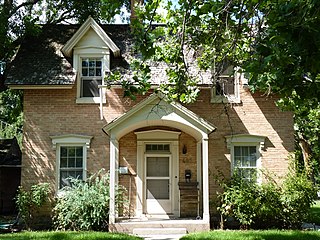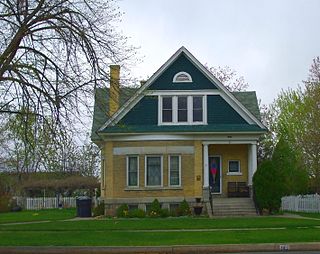
Maeser Elementary was an elementary school in Provo, Utah. It was named after Karl G. Maeser. Built in 1898, it is the oldest school building in Provo, Utah. The school was designed by architect Richard C. Watkins, who also designed the Provo Third Ward Chapel and Amusement Hall, The Knight Block Building, and the Thomas N. Taylor Mansion.

The Beehive House was one of the official residences of Brigham Young, the second president of The Church of Jesus Christ of Latter-day Saints. The Beehive House gets its name from the beehive sculpture atop the house.

The Utah Territorial Statehouse, officially Territorial Statehouse State Park Museum, is a state park in Fillmore, Utah, preserving the original seat of government for the Utah Territory. Built from 1852 to 1855, the statehouse was initially intended as a larger structure, but only the south wing was completed before the project was abandoned due to lack of federal funding, and the Utah Territorial Legislature only met in the building once before the capital was moved to Salt Lake City in 1856.

The Brigham Young Complex is a collection of buildings historically associated with early Mormon leader Brigham Young (1801-1877) on East South Temple in the center of Salt Lake City, Utah. The complex, the surviving part of a once-larger compound belonging to Young, includes the Beehive House, Young's family residence, the Lion House, his official residence as church leader and governor of the Utah Territory, and two small office buildings he used for official business. The complex is a National Historic Landmark District for its association with Young, whose leadership included the rapid expansion of Mormon settlement across the American West. The buildings are now owned by The Church of Jesus Christ of Latter-day Saints ; the Beehive House is open for tours, and the Lion House is operated as an event venue.

The Reed Smoot House, also known as Mrs. Harlow E. Smoot House, was the home of Reed Smoot from 1892 to his death in 1941, and is located at 183 E. 100 South, Provo, Utah, United States. Smoot was a prominent US Senator best known for advocacy of protectionism and the Smoot–Hawley Tariff Act.

Thomas Leavitt House, a brick house built in the nineteenth century in Bunkerville, Nevada, United States, is listed on the National Register of Historic Places.

The Harvey H. Cluff house is a house in central Provo, Utah, United States, built in 1877 that is on the National Register of Historic Places. It was originally owned by Harvey H. Cluff.

Harvey H. Cluff (1836–1916) was a business, civic and educational leader in late-19th-century Provo, Utah.

The Brigham Young Winter Home and Office is a historic residence and museum located in St. George, Utah. Brigham Young was the foremost Mormon pioneer and led the church to the Utah Territory. As Young grew older, his arthritis precluded him from spending winters in the Salt Lake City region, so his followers built him a winter home in St. George in the arid Dixie region of Utah. Young seasonally occupied the home and office from 1873 to 1876. The building was eventually deeded to the division of Utah State Parks and Recreation and is now open as a museum.

The Knight–Mangum House is a historic house located in Provo, Utah, United States. It is listed on the National Register of Historic Places. The mansion was built in the old English Tudor style, completed in 1908. It was built for Mr. W. Lester Mangum and his wife Jennie Knight Mangum. Mrs. Mangum was the daughter of the famous Utah mining man, Jesse Knight. The lot was purchased for $3,500 and the home was built at a cost of about $40,000. The Mangum family was able to afford the home due to the fact that they had sold their shares in Jesse Knight's mine located in Tintic, Utah, for eight dollars a share. They had purchased the shares for only twenty cents a share, so the excess allowed them enough funds to purchase the home. The contractors for the home were the Alexandis Brothers of Provo.

The Johnson–Hansen House is a historic house located in Provo, Utah, United States, that is listed on the National Register of Historic Places.

The Knight–Allen House is a historic house located in Provo, Utah. It is listed on the National Register of Historic Places.
John Erik Forsgren was a Mormon pioneer and missionary. He was the first missionary of The Church of Jesus Christ of Latter-day Saints to preach in Sweden.

Hotel Brigham is a historic three-story hotel building in Brigham City, Utah. It was built in 1914 by George Burnham for James Knudson, a Mormon businessman, and his wife Amelia. It was designed in the Chicago school style by architects Francis Charles Woods and Julius A. Smith, and expanded ten years later, in 1924. The Knudsons died in the early 1940s, and the hotel was acquired by the Hillam Abstracting and Insurance Agency in 1989. It has been listed on the National Register of Historic Places since October 17, 1991.

The Jonathan and Jennie Knudson House is a historic house in Brigham City, Utah. It was built in 1898-1901 by Jonathan Chester Knudson, a Mormon businessman whose father was a Danish-born convert to The Church of Jesus Christ of Latter-day Saints. Knudson lived here with his wife, née Jennie Ellen Pritchard. In the 1930s, the house was inherited by their son, Jonathan Chester Knudson, Jr., also a Mormon businessman, who lived here with his wife, Lucille. It was later deeded to their son, Jake, who lived here with his Japanese wife, Tomie Kono, a Tenrikyo minister. The house remained in the Kudson family until 1998.

The Alma Compton House is a historic house in Brigham City, Utah. It was built in 1908 as a cottage for Alma Compton, an immigrant from England, and designed in the Victorian style. Compton, who became a professional photographer in Brigham City, lived here with his wife, née Jane E. Dalton, his son Matthew, and his two daughters. The Comptons were Mormons. The house has been listed on the National Register of Historic Places since April 7, 1988. The Compton Studio Photographs collection at Utah State University includes "over 100,000 original photographic negatives."

The William F. Butler House is a historic house in St. George, Utah. It was built as an adobe house in 1865 by William Franklin Butler, an early convert to The Church of Jesus Christ of Latter-day Saints. Butler first settled Palmyra, Utah with other Mormon converts in 1852 before moving to Spanish Fork, Utah, where he became a council member. In 1861, after President Brigham Young had asked them to, Butler moved to Southern Utah with more than 300 Mormon families and he became one of the first settlers of St. George. This house was built shortly after, and Franklin lived here with his two wives and many children. It was acquired and expanded by Henry G. Bryner, an immigrant from Switzerland and a Mormon convert, in 1886. It has been listed on the National Register of Historic Places since July 13, 1984.

Parry Lodge is a historic motel-restaurant complex in Kanab, Utah. The main building was built in 1892 for Justin Merrill Johnson, the son of Mormon settlers, who lived here with his wife Emma and their five daughters. Johnson built a barn, and a bungalow was built by Gideon Wilson Findlay, who was married to Mandana Farnsworth, a niece of the Johnsons, and lived here with their six daughters. In 1928, the main house was purchased by three brothers from Salt Lake City, Chauncey, Gronway, and Whit Parry, and more other buildings were erected on the property 1930-1931 as it was turned into a motel-restaurant complex. The buildings were designed in the American Craftsman and Victorian Eclectic styles. The complex has been listed on the National Register of Historic Places since August 14, 2003.

The William Derby Johnson, Jr., House is a historic house in Kanab, Utah. It was built in 1884-1885 for William Derby Johnson, Jr., a veteran of the Black Hawk War of 1865-1872 and a Mormon settler. Johnson had four wives: Lucy Annie Salisbury, Lucy Elizabeth Brown, Charlesetta Prescott Cram, and Mary Agnes Riggs. The house was designed in the Italianate architectural style. It was acquired in 1886 by George Conrad Naegle, who lived here with his two wives, Sabra Higbee Naegle and Anna Fauth. Three years later, it was acquired by Alfred D. Young, who lived here with his wife Ana Little and their thirteen children. By 1900, the house had been remodelled as a hotel, and it was the first hotel in Kanab. The property has been listed on the National Register of Historic Places since April 6, 2001.

The John Henry Shafer House is a historic house in Moab, Utah. It was built in 1884 for John Henry Shafer, a member of The Church of Jesus Christ of Latter-day Saints who moved to Moab from Salt Lake City with other Mormon settlers in 1878. Shafer married Mary Forbush in 1881, and they lived in this house, designed in the Victorian Eclectic style, until she died in 1889. He later married Sariah Eveline Johnson. Shafer was a Republican, and he served as the first member of the Utah House of Representatives from Grand County, Utah. The house was deeded to John Tangren, an immigrant from Sweden, in 1891; he lived here with his wife, Ester Alien, who was the president of the local Relief Society. It later purchased by two ranchers: Dale M. Parriot in 1912, and Richard L. Holyoak in 1941. The house has been listed on the National Register of Historic Places since May 2, 2001.




















